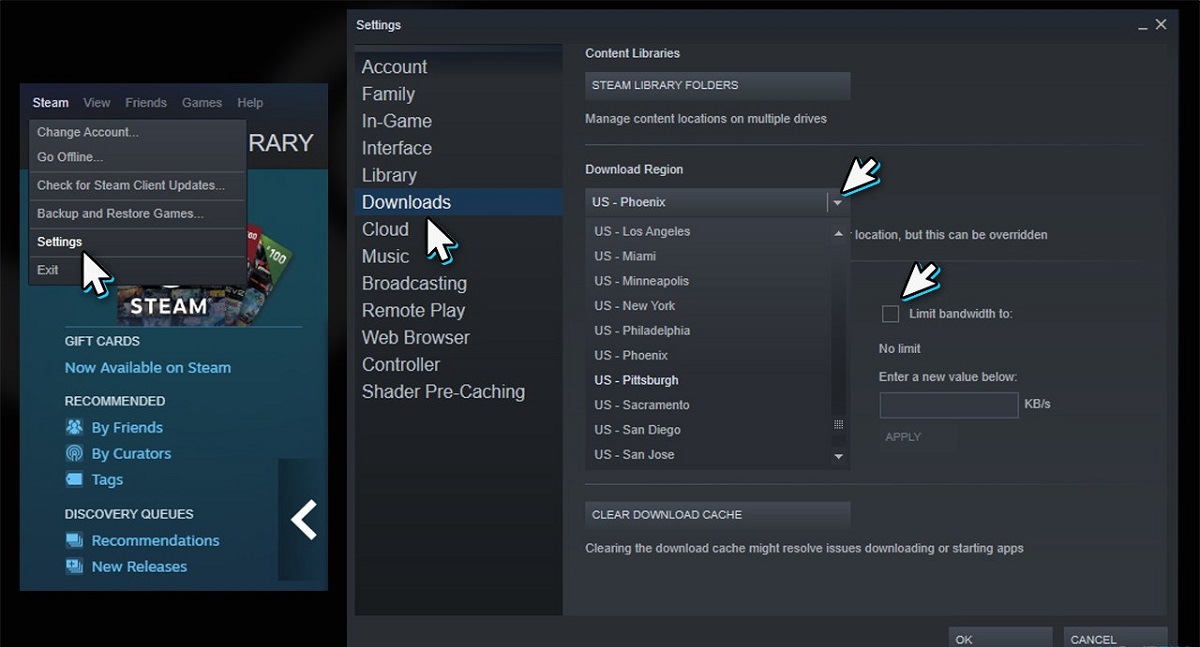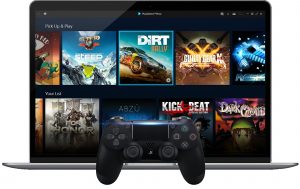Introduction
Are you frustrated with slow download speeds on Steam? Don’t worry, you’re not alone. Many gamers have experienced the frustration of waiting hours for a game to download, only to find that their internet connection is not up to speed. Slow download speeds can put a damper on your gaming experience, causing delays and interruptions when you just want to jump into the action. However, there are several strategies that you can employ to increase your Steam download speed and get back to gaming faster.
In this article, we will explore various methods to improve your Steam download speed. From optimizing your computer’s settings to changing your download region, these techniques can help you maximize your internet connection and make the most of your gaming experience. By following these steps, you can overcome the frustration of slow downloads and start enjoying your favorite games without any delays.
We understand that waiting for downloads can be a tedious and frustrating experience, especially when you’re excited to play a new game or join your friends in an online match. That’s why we have compiled a comprehensive list of solutions to help you overcome slow download speeds on Steam. Whether you’re a casual gamer or a hardcore enthusiast, these tips and tricks can make a significant difference in your downloading experience.
But before diving into the solutions, it’s important to note that your internet connection speed is a crucial factor in determining your download speed. It’s worth checking your current internet speed using an online speed test tool. This will give you a baseline to compare against after implementing the following strategies. With that said, let’s get started and discover how you can increase your Steam download speed and spend less time waiting and more time gaming.
Check your internet connection speed
Before diving into troubleshooting methods, it’s important to determine your current internet connection speed. Slow download speeds on Steam could be attributed to a sluggish internet connection. To check your internet speed, you can use various online speed test tools such as Ookla’s Speedtest or Fast.com. These tools will measure your download and upload speeds as well as your ping (response time) to a nearby server.
Once you have conducted the speed test, compare the results to the internet plan you are subscribed to. If the speeds are significantly lower than what you’re supposed to be getting, there may be an issue with your internet service provider (ISP). Contact your ISP to troubleshoot the issue further and discuss potential solutions.
Additionally, you should consider running the speed test at different times of the day. Internet speeds can fluctuate depending on the time of day and the network congestion in your area. If you find that your speeds are consistently low, even during off-peak hours, it’s advisable to contact your ISP to investigate the problem.
Keep in mind that the download speeds provided by your ISP are typically advertised as “up to” a certain Mbps (megabits per second). The actual speeds you experience may vary due to various factors, including network congestion and distance from the ISP’s server. However, if your speeds are significantly lower than the advertised range, it’s worth addressing the issue with your ISP to ensure you’re getting the service you’re paying for.
If you determine that your internet speeds are within the expected range, then the issue may lie elsewhere, and you can move on to the next troubleshooting steps to improve your Steam download speed.
Close unnecessary programs and downloads
When you’re trying to download games on Steam, it’s important to optimize your computer’s resources to ensure that the download speed is not hindered by unnecessary programs or downloads running in the background. Closing unnecessary programs and downloads can free up system resources and bandwidth, allowing Steam to utilize them for faster downloads.
Start by closing any programs that are running in the background and consuming significant system resources. These can include resource-intensive applications like video editing software, antivirus scans, or heavy web browsers with multiple tabs open. By freeing up system resources, you allocate more processing power and bandwidth to Steam, enhancing the download speed.
In addition, check your download manager or any other programs that may be downloading files in the background. These downloads can consume bandwidth, thereby slowing down your Steam download speed. Pause or cancel these unnecessary downloads to prioritize the Steam download and maximize your internet connection speed.
It’s also worth noting that sometimes, certain programs may have automatic updates enabled, and they might download updates in the background without your knowledge. Therefore, it’s a good practice to check your system’s automatic update settings and temporarily disable them while downloading games on Steam.
If you’re unsure which programs may be running in the background and consuming system resources, you can use the Task Manager (Ctrl+Shift+Esc) on Windows or Activity Monitor on macOS to identify these programs. These built-in system tools provide detailed information about running processes, CPU usage, and memory consumption, helping you identify resource-hungry programs that may impact your Steam download speed.
By closing unnecessary programs and downloads, you can create a more favorable environment for Steam to utilize your internet connection at its maximum potential. This simple step can have a significant impact on your download speed, allowing you to get your games downloaded and start playing them faster.
Change your download region
Changing your download region is another effective strategy to increase your Steam download speed. Steam utilizes content servers located around the world to distribute game files and updates. By default, Steam automatically assigns you to a specific download region based on your geographical location.
However, sometimes the default download region might not have optimal server performance or may be experiencing high traffic, leading to slower download speeds. In such cases, manually changing your download region can help improve your download speed.
To change your download region on Steam, follow these steps:
- Launch the Steam application and go to “Steam” on the top left corner of the client.
- Select “Settings” from the dropdown menu.
- In the Settings window, navigate to the “Downloads” tab.
- Under the “Download Region” section, click the dropdown menu and choose a different region that is geographically close to your location.
- Click “OK” to save the changes.
After changing your download region, restart Steam to apply the new settings. Steam will now connect to the content servers in the selected region, which might offer better performance and faster download speeds.
It’s important to note that changing your download region does not have any impact on the games you own or your account settings. It only affects the content download servers Steam connects to for future downloads.
Experiment with different download regions to find the one that provides the best download speed for your location. It’s recommended to choose a region that is geographically closer to you, as closer servers tend to offer lower latency and faster download speeds.
If you’re unsure which download region to choose, you can use the “Speed Test” option within the Steam client. This feature allows you to test the download speeds of different regions and select the one with the highest speed, ensuring optimal performance for your game downloads.
By changing your download region, you can potentially experience significant improvements in your Steam download speed, allowing you to download games and updates faster and get back to gaming without the frustrating delays.
Clear your download cache
If you’re experiencing slow download speeds on Steam, it’s worth clearing your download cache to resolve any potential issues with the cached data. The download cache is a temporary storage location where Steam stores game files and updates that have been downloaded.
Over time, the download cache can become bloated or corrupted, which can lead to slow download speeds or other download-related problems. Clearing the cache will force Steam to rebuild it, potentially improving your download speed.
To clear the download cache on Steam, follow these steps:
- Open the Steam application and go to “Steam” on the top left corner of the client.
- Select “Settings” from the dropdown menu.
- In the Settings window, navigate to the “Downloads” tab.
- Click the “Clear Download Cache” button. A confirmation dialog box will appear.
- Click “OK” to proceed with clearing the download cache.
Once the cache has been cleared, restart Steam for the changes to take effect. Steam will now rebuild the download cache as you start downloading games or updates.
Clearing the download cache not only helps improve download speeds but can also resolve issues such as games getting stuck during the downloading process or encountering installation errors. It’s a simple yet effective troubleshooting step that can help optimize the download process on Steam.
Keep in mind that clearing the download cache will not delete any of your installed games or personal data. It only removes temporary files related to the download process. Your game files and settings will remain intact.
If you’re still experiencing slow download speeds after clearing the cache, it’s recommended to try the other methods discussed in this article to further optimize your Steam download speed.
By clearing your download cache, you can ensure that Steam starts with a fresh cache, eliminating any potential issues that may be hindering your download speed. This can result in faster and smoother downloads, allowing you to quickly get back to enjoying your games without any frustrating delays.
Update your Steam client
One of the simplest yet often overlooked solutions for slow download speeds on Steam is ensuring that your Steam client is up to date. Steam regularly releases updates to improve performance, fix bugs, and introduce new features. By keeping your Steam client updated, you can ensure that you’re benefiting from the latest optimizations and enhancements that can potentially improve your download speed.
Steam automatically checks for updates and prompts you to update when a new version is available. However, it’s possible that you may have disabled or missed the update prompt. To manually check for updates and update your Steam client, follow these steps:
- Launch the Steam application and sign in to your account.
- Click on “Steam” in the top-left corner of the client.
- Select “Check for Steam Client Updates” from the dropdown menu.
- If an update is available, Steam will start downloading and installing it automatically.
- Once the update is complete, restart Steam for the changes to take effect.
It’s important to note that updating your Steam client may require a brief interruption in your gaming session, as the client needs to restart. Therefore, it’s advisable to save your progress in any active games before initiating the update.
By regularly updating your Steam client, not only can you potentially see improvements in download speed, but you also ensure compatibility with the latest games and features. Outdated clients may experience compatibility issues or encounter download-related bugs that can affect your overall gaming experience.
If you’re unsure whether your Steam client is up to date or encountering issues with updating, you can visit the official Steam website and download the latest version of the client directly from the website.
Remember, a well-maintained and up-to-date Steam client is essential for optimal performance, including fast and seamless downloads. Take a few minutes to update your client, and you may be pleasantly surprised by the improvements in your download speeds.
Optimize your computer’s settings
Optimizing your computer’s settings can significantly impact your Steam download speed. By making a few adjustments and tweaks, you can ensure that your system is running at its best, allowing for faster and more efficient downloads. Here are some settings you can optimize:
- Power Management Settings: Adjusting your computer’s power management settings can prevent your system from entering power-saving modes while downloading games. These modes can limit your computer’s performance and potentially slow down downloads. Set your power plan to “High Performance” to ensure maximum performance during downloads.
- Firewall and Antivirus Settings: Firewalls and antivirus software are important for protecting your computer, but they can also interfere with Steam downloads. Add Steam as an exception in your firewall and antivirus settings to prevent them from slowing down or blocking the download process.
- Windows Update: Keeping your operating system up to date is crucial for optimal performance. Regularly check for Windows updates and install them to ensure that your system is running smoothly and efficiently. Outdated operating systems can potentially cause compatibility issues and hinder download speeds.
- Network Adapter Settings: Adjusting the settings of your network adapter can help improve your download speed. Access the Device Manager, locate your network adapter, and make sure that the “Power Management” option is unchecked to prevent your computer from shutting down or limiting network activity during downloads.
- Clearing Temporary Files: Regularly clearing temporary files and caches on your computer can free up valuable disk space and improve overall performance. Use built-in disk cleanup tools or third-party software to remove unnecessary files, including temporary internet files and downloads.
- Updating Device Drivers: Outdated or corrupted device drivers can impact your computer’s performance, including download speeds. Visit the manufacturer’s website or use driver update software to ensure that your drivers are up to date. Focus on network adapter and graphics card drivers, as they can directly affect your download experience.
Optimizing your computer’s settings is a proactive approach to ensure that your system is running efficiently and capable of handling Steam downloads at maximum speed. These adjustments can vary based on your operating system and hardware configuration, so it’s important to research and apply the appropriate settings for your specific setup.
By taking the time to optimize your computer’s settings, you can remove potential bottlenecks and ensure that your system is running smoothly, resulting in faster download speeds and an improved gaming experience on Steam.
Limit the bandwidth used by Steam
If you’re experiencing slow download speeds on Steam, it may be helpful to limit the bandwidth used by the Steam client. By allocating a specific portion of your internet connection’s bandwidth to Steam, you can prevent it from consuming all available bandwidth and causing slowdowns in other online activities.
To limit the bandwidth used by Steam, follow these steps:
- Launch the Steam application and sign in to your account.
- Click on “Steam” in the top-left corner of the client.
- Select “Settings” from the dropdown menu.
- In the Settings window, navigate to the “Downloads” tab.
- Under “Download Restrictions,” check the box next to “Limit bandwidth to” and adjust the slider to allocate the desired amount of bandwidth.
- Click “OK” to save the changes.
By limiting the bandwidth used by Steam, you ensure that other online activities, such as web browsing or streaming content, are not negatively affected by the download process. Allocating a specific bandwidth prevents Steam from monopolizing your internet connection and allows for a better balance of resources.
Keep in mind that the amount of bandwidth you allocate to Steam should depend on your internet connection speed and the capacity you want to reserve for other activities. If you have a fast internet connection, you can allocate a larger portion of bandwidth to Steam. However, if your connection is relatively slow, it’s advisable to allocate a smaller portion to avoid affecting other online activities.
By optimizing the bandwidth usage of Steam, you can ensure that downloads proceed smoothly without creating any disruptions in your other online activities. It’s a useful technique to make the most of your internet connection and improve your overall download experience.
Disable unnecessary Steam features
Steam offers a variety of features and settings that enhance the gaming experience. However, some of these features can consume system resources and affect the download speed of games and updates. By disabling unnecessary Steam features, you can free up resources and allocate them towards faster downloads.
Here are some features you can consider disabling:
- Steam Overlay: The Steam Overlay is a feature that allows you to access in-game options, chats, and web browsing without exiting your game. While useful, it can consume system resources and affect download speeds. Consider disabling this feature by going to Steam settings, selecting the “In-Game” tab, and unchecking the “Enable the Steam Overlay while in-game” option.
- Automatic Updates: By default, Steam automatically updates your installed games. Although this ensures that you’re always running the latest versions, it can also slow down downloading of new games or updates. You can disable automatic updates by going to Steam settings, selecting the “Downloads” tab, and unchecking the “Allow downloads during gameplay” and “Always keep my games up to date” options. You can manually update your games later when it’s more convenient.
- Background Downloads: Steam allows you to download games and updates in the background while you continue using the client. However, background downloads can slow down your internet connection and affect download speeds. You can pause or prioritize downloads manually by going to the Steam library, right-clicking on the game or update, and selecting the appropriate option.
- Friends List Notifications: Steam’s friends list notifications can be distracting and can consume system resources. You can disable these notifications by going to Steam settings, selecting the “Friends” tab, and unchecking the “Display a notification” option.
By disabling unnecessary Steam features, you can streamline the client’s operation and prioritize download speed. This allows Steam to utilize your system resources efficiently and focus on downloading games and updates without any additional overhead.
Choose only the features that you find unnecessary or that impact your download speed. Every system configuration is different, so you can experiment with disabling various features to see which ones have the most significant impact on your download performance.
Remember that you can always re-enable these features whenever desired, depending on your gaming and usage preferences. By customizing Steam to your needs and disabling unnecessary features that hinder download speeds, you can ensure a smoother, faster, and more efficient gaming experience.
Use a wired connection instead of Wi-Fi
When it comes to maximizing your download speed on Steam, one effective solution is to switch from a Wi-Fi connection to a wired connection. While Wi-Fi offers convenience and flexibility, it can be less stable and suffer from interference, resulting in slower download speeds. Connecting your computer directly to the router using an Ethernet cable provides a more reliable and consistent connection, which can significantly improve your download speed.
Here are a few reasons why using a wired connection is beneficial:
- Stability: Unlike Wi-Fi, which can be affected by environmental factors, physical obstructions, and interference from other devices, a wired connection offers a stable and consistent connection. This stability ensures a faster and more reliable data transfer, resulting in improved download speeds.
- Consistent Bandwidth: Wired connections typically provide a more consistent and reliable bandwidth compared to Wi-Fi. This means that you can consistently utilize the maximum speed of your internet connection without fluctuations or interruptions, resulting in faster downloads on Steam.
- Reduced Interference: Wi-Fi signals can be affected by interference from other devices in your vicinity, including other Wi-Fi networks, microwaves, or cordless phones. By using a wired connection, you eliminate these sources of interference, providing a cleaner connection and higher download speeds.
To switch from Wi-Fi to a wired connection, simply connect one end of an Ethernet cable to your computer’s Ethernet port and the other end to an available port on your router or modem. Once connected, your computer should automatically detect the wired connection, and you’ll be ready to experience faster download speeds on Steam.
If you have multiple devices connected to your network and need to use Wi-Fi for other devices, consider using a wired connection specifically for your gaming computer or the device you use for Steam downloads. This dedicated wired connection can ensure optimal download speeds without affecting other devices on the network.
However, if using a wired connection is not feasible due to distance or other limitations, there are still steps you can take to optimize your Wi-Fi connection. These include reducing interference by placing your router in a central location, minimizing obstacles between your device and the router, and using a Wi-Fi extender or mesh system to improve signal coverage.
Remember, while Wi-Fi offers convenience, a wired connection is generally the preferred option for maximizing download speeds on Steam. By making the switch, you can enjoy faster, more reliable downloads and ensure a smoother gaming experience.
Check for background downloads
If you’re experiencing slow download speeds on Steam, it’s essential to check for any ongoing background downloads that may be impacting your current download speed. Steam allows you to download multiple games or updates simultaneously, which can divide your available bandwidth and result in slower speeds for all downloads.
To check for background downloads on Steam, follow these steps:
- Open the Steam application and sign in to your account.
- Click on “View” in the top-left corner of the client.
- Select “Downloads” from the dropdown menu.
In the “Downloads” window, you’ll see a list of ongoing or queued downloads. If there are any active downloads apart from the one you’re currently concerned about, it’s likely contributing to the slower download speed.
To prioritize your desired download, you can pause or cancel the background downloads. Right-click on the download you want to pause or cancel and select the appropriate option. Pausing or canceling other downloads will free up bandwidth and allow your desired download to utilize a larger portion of your available speed.
If you have multiple downloads queued, consider prioritizing the download that you want to complete first. Right-click on the desired download and choose “Move to top of queue” to ensure it starts immediately.
It’s worth noting that pausing or canceling other downloads may temporarily halt progress on those games or updates. However, once you’ve completed the download you prioritized, you can resume the paused downloads or start new downloads at a more convenient time.
Regularly checking for background downloads and managing your active downloads can help you allocate your internet speed more effectively and ensure that your desired games or updates complete in a timely manner.
By monitoring and controlling background downloads on Steam, you can optimize your download speed, minimize any unnecessary traffic, and improve your overall gaming experience.
Use a download accelerator
If you’re looking to significantly boost your download speed on Steam, consider using a download accelerator. Download accelerators are third-party tools specifically designed to enhance the download process by utilizing multiple connections, optimizing bandwidth usage, and maximizing the available speed.
These tools work by splitting the download file into smaller parts and downloading them simultaneously, often from multiple servers. This allows for faster and more efficient downloads, especially for larger files or slower connections.
There are various download accelerator options available, both free and paid, each with its own set of features. Here are a few popular download accelerator tools:
- Internet Download Manager (IDM): IDM is a popular download accelerator that integrates seamlessly with web browsers and improves the download speeds by up to five times. It offers features such as pause, resume, and schedule downloads, as well as the ability to download videos from streaming sites.
- JDownloader: JDownloader is a free, open-source download manager that supports various platforms. It allows users to queue and download multiple files simultaneously, enabling faster and more convenient downloads.
- BitComet: BitComet is a free BitTorrent client that also functions as a download accelerator. It utilizes P2P (peer-to-peer) technology to download files from multiple sources, resulting in improved speeds for large files.
- uGet: uGet is a lightweight and free download manager that supports downloading from a wide range of protocols. It offers features like batch downloading, clipboard monitoring, and download acceleration to enhance the overall downloading experience.
Once you have chosen a download accelerator, download and install the software onto your computer. Additionally, configure your web browser or the download accelerator itself to integrate seamlessly with Steam. This way, you can initiate and manage downloads directly through the accelerator, ensuring faster and more efficient downloading.
While using a download accelerator can significantly improve your download speeds on Steam, it’s worth mentioning that the actual improvements may vary depending on your internet connection and the specific server from which you’re downloading. Results may also differ based on the file size and the number of connections supported by the server hosting the content.
Remember to scan any third-party software you download for malware or potentially unwanted programs (PUPs) before installing them on your computer. Stick to reputable sources and always prioritize the security of your system.
By utilizing a reliable download accelerator, you can enhance your Steam download speed and reduce waiting times for game downloads and updates. These tools optimize the download process, increasing efficiency and helping you get into the gaming action faster.
Contact your internet service provider
If you’ve tried all the previous methods and are still experiencing slow download speeds on Steam, it may be time to reach out to your internet service provider (ISP) for assistance. Your ISP is responsible for delivering your internet connection and ensuring that you receive the advertised speeds.
Here are a few steps to take when contacting your ISP:
- Perform speed tests: Before reaching out to your ISP, make sure to conduct multiple speed tests using reputable online tools. Record the results along with the date and time of the tests. This data will help you demonstrate the discrepancy between the promised speeds and the actual speeds you’re receiving.
- Gather relevant information: Collect information about your internet plan, including the download and upload speeds promised by your ISP. Locate your account details, such as your account number and contact information, as these may be required during your interaction with customer support.
- Contact customer support: Reach out to your ISP’s customer support department via phone, email, or live chat. Explain the issues you’re experiencing with your download speeds on Steam. Provide them with the speed test results and any other relevant information you’ve gathered.
- Ask for assistance: Request that your ISP investigates and troubleshoots the slow download speeds on your connection. They may be able to identify any network congestion, technical issues, or configuration problems that could be impacting your download speeds. Follow any troubleshooting steps they provide and provide them with any requested information or logs.
- Escalate the issue if necessary: If your initial contact with customer support doesn’t resolve the problem, consider escalating the issue to a supervisor or a higher level of support. Be polite but firm in your request for a resolution. Remember that persistence and clear communication are key when dealing with customer support.
- Explore other ISPs: If you continue to face persistent slow download speeds and your ISP is unable to provide a satisfactory resolution, consider researching alternative ISPs in your area. Compare their plans, prices, and customer reviews to ensure you’re selecting a reliable provider that meets your needs.
When contacting your ISP, it’s important to remain patient and understanding. Customer support representatives are there to assist you, and maintaining a respectful and cooperative attitude can help facilitate a resolution to your issue.
Keep in mind that there may be external factors beyond your ISP’s control that can impact your download speeds, such as network congestion or server limitations. However, by bringing the issue to their attention, you increase the likelihood of finding a solution or potentially identifying any underlying issues affecting your connection.
Remember to document your interactions with customer support, including dates, names of representatives, and the steps they’ve taken to address the issue. This information can be useful for future reference and can expedite the troubleshooting process.
By contacting your ISP and seeking their assistance, you’re taking a proactive step towards resolving slow download speeds on Steam. Working together, you can troubleshoot and identify any issues that may be impeding your download experience and find a resolution that ensures you’re getting the speeds you’re paying for.

























